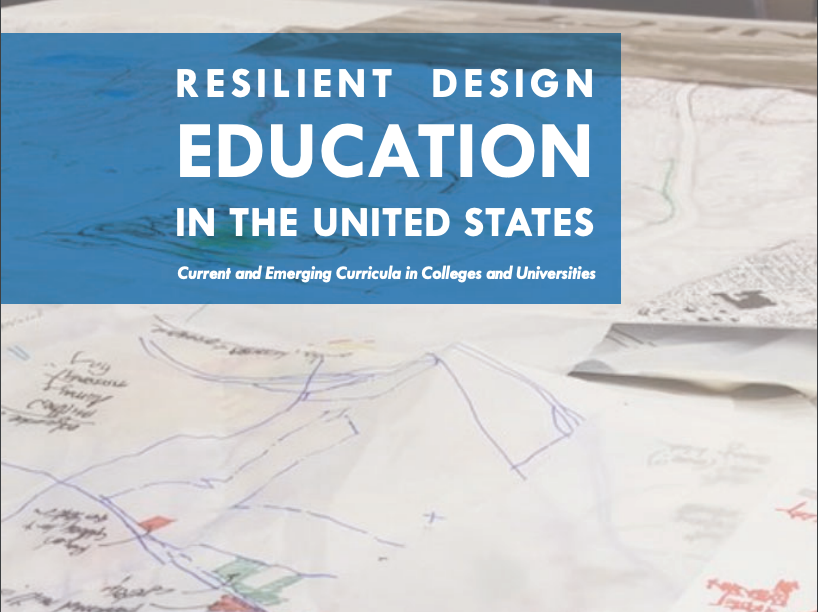The growing cost and frequency of natural hazards point to a need to better educate and train future designers and practitioners, according to a new study from the Coastal Resilience Center of Excellence (CRC), but such education programs are not currently suitable to fit the growing need.
These conclusions are part of a study undertaken by the CRC to study how resilient design is taught, “Resilient Design Education in the United States.” The study was undertaken as part of a 2016 federal action from the Obama administration, recognizing the role of Resilient Design Education in a resilient future.
The U.S. experienced its most expensive series of natural hazards in history last year, totaling more than $300 billion in estimated damages, according to the National Oceanographic and Atmospheric Administration. The record levels of destruction come in part due to a combination of the effects of extreme weather and a lack of resilient community and infrastructure design; growth and development patterns often push people into areas at risk for repeated disasters, exponentially raising costs. Further complicating the situation is that organizational and incentive structures in U.S. colleges and universities pose many barriers to delivering a high-quality resilient design education, according to the study’s authors.
“The rising cost of disasters and the human suffering that occur in the aftermath have made the call to design communities resiliently more important than at any other time in history,” according to the study. “The proactive application of sound resilient design approaches reduces the likelihood of disasters occurring in the first place and should a disaster occur, they facilitate a return to a new normal in which communities are defined by a more equitable and socially cohesive condition, local economies are diversified and robust, physical and social vulnerabilities are reduced, and the natural environment is protected and restored.”
The project included a literature review and landscape survey by the CRC, which examined the established state-of-the-art in the science and education of resilient design.
The CRC is funded by the Department of Homeland Security (DHS), Science and Technology Directorate (S&T) Office of University Programs (OUP).
The study finds that resilient design is a small but rapidly growing field, with several universities and colleges creating degrees, minors and certificate programs focusing on the subject. However, these disciplines remain focused on one element of resilient design instead of having interdisciplinary approaches.

“This report provides a set of actionable steps to inject ‘resilience thinking’ into existing and emerging design curricula spanning US colleges and universities,” said Dr. Gavin Smith, CRC Director, UNC-Chapel Hill professor and co-author of the study. “The rapid – albeit uneven – growth of classes, minors, degrees, studios and programs makes these findings highly relevant as we enter an era of climate change and continue to struggle with the ever-increasing losses associated with disasters.”
The study included identifying science and education approaches that integrate resilient design across disciplines such as mathematics, economics, engineering, architecture, urban planning, community planning, climate science, risk science and social science. Examples would include a program that combines architectural design with engineering and climate science.
“Our past experiences with natural hazards and disasters do not adequately prepare us for future events,” said Dr. Mai Nguyen of UNC-Chapel Hill, a co-author of the study. “We need to reevaluate the curricula at U.S. colleges and universities in order to equip a new generation of students with the knowledge and skills to prepare for and respond to future disaster events. We must train future scholars and practitioners with the state-of-the art knowledge that incorporates interdisciplinary, systems-based, multi-scalar thinking to design more resilient communities. If the last few years are any indication of the economic and human toll resulting from disasters that is yet to come, designing resilient structures, communities, regions, ecosystems and economies will be more important than ever.”

CRC Education and Workforce Development Grant recipients Colleen Durfee and Darien Williams, both recent master’s graduates from UNC-Chapel Hill, are contributing authors of the report. Authors also include former Grant recipient Ashton Rohmer and current UNC-Chapel Hill doctoral student Nora Schwaller. Several of the co-authors participated in a panel at the Natural Hazards Workshop in Colorado in July.
The rapid growth of classes, minors, degrees, studios and programs makes these findings highly relevant as we enter an era of climate change and continue to struggle with the ever-increasing losses associated with disasters.
Beyond classroom learning, research centers, institutes and extension programs offer students project-based and experiential learning opportunities, according to the study. These spaces provide opportunities for inter- and multi-disciplinary collaborations between faculty, students and practitioners can take place.
The authors identified several goals to improve the availability of interdisciplinary resilient design education in the United States:
- Improve institutional commitment from colleges and universities across disciplines and departments.
- Develop new curricula models and organizational structures to emphasize opportunities for research and engagement, beyond classroom learning.
- Build interdisciplinary teams with a mix of faculty, practitioners and policy-makers to teach and mentor students.
- Emphasize field and studio-based projects for a “learning by doing” approach to foster innovation, room to fail and the ability to fix problems.
- Create flexible and responsive curricula for post-disaster situations, which provide many learning opportunities and opportunities for field work.
- Seek out national, state and local stakeholders that could serve as ongoing “clients” or sounding board for curriculum content and products developed by students and faculty.
The full study can be found at https://unc.live/2zRWalV.

